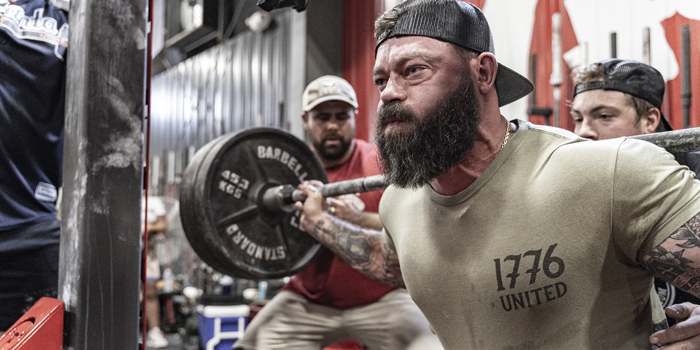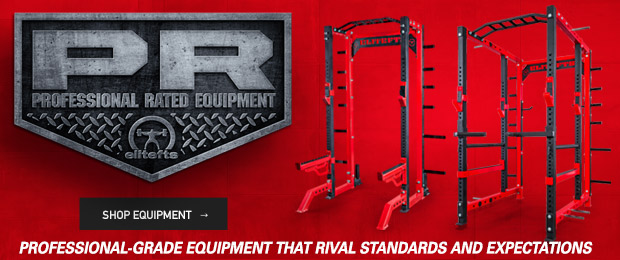
If you go digging for conjugate-related articles, you’ll likely find everything under the sun regarding dynamic effort cycles, bands, chains, exercises popularized by Louie Simmons and Dave Tate, and new principles you can implement into your training. What seems to be lacking is max effort cycles and how to appropriately line up your main movements to see progress.
While most conjugate-based training aims to bring up weak points (and rightfully so), how you set up your max effort work is crucial to setting up the rest of the session. You shouldn’t just pick a random exercise and run with it for the day. You should certainly have staples that you know help show progress (testers), and you’ve got the staples that you know consistently give you that progress (builders).
Below are five max effort cycles that I’ve run personally and with clients, and ones you can use to immediately align your training and hopefully hit new PRs here soon.
Below I’ll briefly describe the cycle and then provide some examples.
Ascending Cycle
The Ascending Cycle is all about building up in load over the next three to four weeks. How long you want your lifts to build up in load is what works best for you. The nice thing here is that as you redo the cycle, your body will get a mini “deload” as loads decrease agree. Dave has talked about setting your max effort cycle up like this in the past.
- Week 1: Front Squat
- Week 2: SSB Squat
- Week 3: Back Squat vs Bands
- Week 4: Reverse Band Box Squat
As you can see in the example above, the loads you should be using each week will naturally increase.
Descending Cycle
The Descending Cycle is essentially the opposite of the Ascending Cycle. It works great as you approach a meet to allow more central nervous system recovery but still take some hard singles to address strength and places where you need improvement. Here’s an example with the bench press in mind:
- Week 1: 2-Board Press
- Week 2: Reverse Mini Band Bench Press
- Week 3: Bench Press
- Week 4: Close Grip Spoto Press
As mentioned, you should see loads you’re able to use for this cycle decrease over the four-week cycle.
Wave Cycle
The Wave Cycle is one of my favorites and, while more advanced, is a great way to get out of ruts. It focuses on adjusting the nervous system response you get to benefit in the upcoming weeks. Generally, you’ll see this in three-week waves to see the best results.
What you’ll do is pick a mechanical disadvantageous lift, an advantageous lift, and then your realization-based lift. This works awesome for sports training as well, as most coaches want to stick close to the main movements, and this cycle allows you to return to the main lift rather frequently. Below I’ll provide a squat and deadlift variation of the cycle.
Squat Cycle
- Week 1: Front Squat
- Week 2: Reverse Band Squat
- Week 3: Back Squat
Deadlift Cycle
- Week 1: Deficit Deadlift
- Week 2: Block Pull From Mid Shin
- Week 3: Deadlift
*Use preferred stance*
As you can see, this creates peaks and valleys, which can be great for building the nervous system up for a peak on test day (or a meet), and also great for in-season athletes that know they have certain weeks where you’ll need to pull back (big conference game) and then a bye week where you can push things a bit more.
Triphasic Cycle
The Triphasic Cycle is built off the principles of the triphasic system. My good friend Christian Anto has amazing material for using the triphasic principles in powerlifting, so I would highly suggest you read his material if you want to go deeper into this topic.
For this wave, it’s relatively simple to set up. It’s a four-week wave consisting of an eccentric option, isometric option, and concentric option followed by the main movement you’re looking to improve. Here’s a good bench press wave:
- Week 1: 5-Second Eccentric Bench Press
- Week 2: 5-Second Spoto Press (pause just off chest)
- Week 3: Pin Press (just off chest)
- Week 4: Bench Press
As you can tell, the goal is to specifically focus on just that adaption for the week. You can certainly drag this out to seven weeks by doing two-week mini-waves of each, but I’ve found this works better if you’re going to use the principles for your supplemental work.
5/3/1 Cycle
5/3/1 is one of my favorite cycles to use for beginner to intermediate lifters and athletes. It provides ample practice with the movements and helps the athletes get used to taking heavier weights if that’s what you need to teach them. Find two movements that you want in your program to work on, and you’ll use them for the next six weeks. For this example, I’m going to use the squat as an example lift we’re going to improve.
- Week 1 - Front Squat 5RM
- Week 2 - Back Squat 5RM
- Week 3 - Front Squat 3RM
- Week 4 - Back Squat 3RM
- Week 5 - Front Squat 1RM
- Week 6 - Back Squat 1RM
- Deload
Notice that I didn’t pick any crazy variations (although you can pick whatever variations you need, clearly), but I’ve found this works better with less experienced lifters and athletes. They can usually make progress on lifts by merely getting better at them, so you’ll want to use that to your advantage with a cycle like this.
Putting It All Together
Hopefully, some of these cycles can go on to help you break some PRs, train your teams better, or overall give you some guidance on how to cycle and set up your max effort work. With some thought processes and attacking your weak points, you’ll find that you can not only get more from your max effort work but hopefully see progress quicker.
Brandon Smitley is a 2011 graduate of Purdue University where earned his Bachelor’s degree in Health and Fitness, and of Indiana State University with his Master's Degree in Coaching. His best lifts to date are a 567-pound squat, 330-pound bench, 510-pound deadlift, and 1377-pound total in the 132-pound weight class! Brandon holds his CSCS, USAW, and CPT certifications. He has opened THIRST with his wife, Adrian, to help athletes and others realize their full potential from proper strength training methodologies.











1 Comment